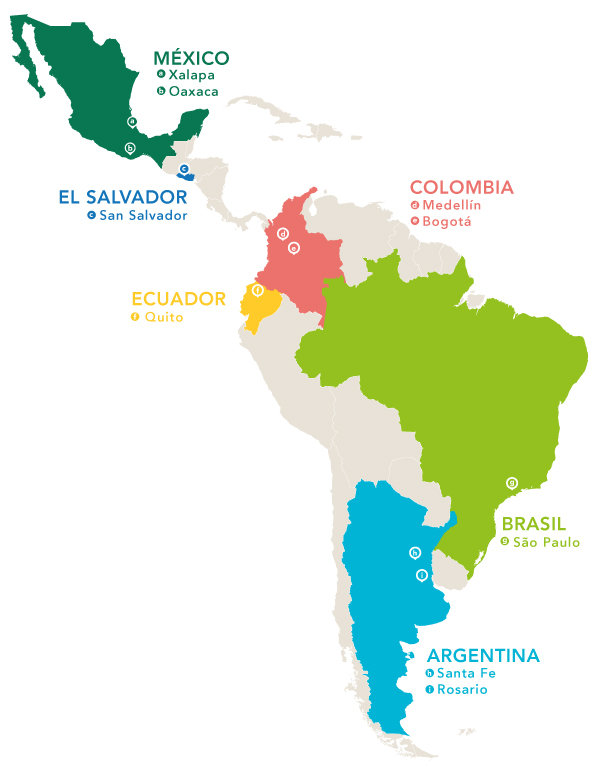
Climate impacts in Latin America and the Caribbean are increasing in frequency and intensity, with a high percentage of extreme events caused by climatic factors. Considering that a large part of the population lives in urban areas, the need to transform the planning of these zones to increase their resilience is becoming increasingly urgent.
Nature-based Solutions (NbS) can be effective in enhancing the natural functions of ecosystems in urban areas, but they require long-term commitment and informed citizen participation. Achieving this transformation requires institutional frameworks, planning tools, inclusive processes, and a sustainable financial strategy, with a focus on local climate action in Latin America and the Caribbean.
Discover in this publication the different approaches of NbS for Latin American cities, as well as regional information, tools, and evidence to guide urban planning, strengthening long-term resilience planning and decision-making strategies.
48% of the capitals of Latin America and the Caribbean are exposed to extreme risk due to the impacts of climate change.
8 out of 10 people in Latin America and the Caribbean live in urban areas, and it is estimated that this number could reach 85% by 2040.

This post was directed by Marta Moneo, Lili Ilieva, and Ophélie Drouault from the Adaptation team of the Climate Change Unit, UNEP – Latin America and the Caribbean. It was edited by Daniel Kozak, director of the Habitat and Energy Research Center at UBA and a CONICET researcher (Argentina).
Cities and Watersheds: the essential link for climate resilience in cities.
Cities and the watersheds surrounding them maintain an essential connection in the context of climate change. Urban areas depend on the surrounding watersheds for a range of vital ecosystem services that play a fundamental role in climate resilience. In this context, healthy watersheds play a key role in managing the water cycle for urban areas, regulating the distribution and flow of water, thereby reducing the risk of floods and enhancing water security.

Author: Daniel Kozak
Director of the Habitat and Energy Research Center of the University of Buenos Aires and researcher at the National Scientific and Technical Research Council of Argentina.
Climate Risk Analysis at Watershed Scale: A Key Approach for Integrated Planning Based on Climate Risks and Impacts in Cities.
Climate risk analysis at the watershed scale is a key tool driving resilience in cities. Climate risks are complex and encompass multiple dimensions, from climate patterns to land use, water resources, and ecosystems. But to truly understand vulnerability and risks, we must look beyond the boundaries of cities and consider a multiscale perspective. By analyzing climate risks at the watershed, peri-urban, and urban levels, we gain a comprehensive insight into how climate change impacts vital ecological functions for urban resilience. From identifying critical vulnerability points to understanding the origins of flooding, this approach provides a holistic and accurate understanding of how to address climate challenges and build cities ready for the future.

Author: Manuel Winograd
Contributor: Michiel van Eupen
Advisor and researcher in vulnerability and adaptation to climate change at Wageningen University & Research.
Participatory Governance for an Inclusive and Sustainable Future in Resilient Urban Environments.
Participatory governance in the processes of building urban resilience with NbS is essential to ensure inclusion, recognition of local knowledge, community empowerment, and accountability. By engaging a wide range of stakeholders in the decision-making process, it is possible to develop and implement more effective and sustainable solutions that address urban challenges and promote long-term resilience. Empowering citizens in all their diversity, considering social differentiation to ensure equitable representation of voices, as well as involving actors from the private sector, civil society, academia, and others, is crucial to ensure fair representation and effectiveness of solutions. The needs, values, and knowledge of the most vulnerable populations must be at the forefront of planning, policy, and implementation.

Author: Jorgelina Hardoy
General coordinator and senior researcher at the International Institute of Environment and Development, IIED – Latin America based in Buenos Aires.
The Transformative Power of Ecosystems in Building Resilient Cities.
Ecosystems have the capacity to control floods, mitigate droughts, improve air quality, and regulate urban microclimates, making them a key element in building urban resilience. At all scales, from wetlands to forested areas in cities and peri-urban zones, they act as natural sponges that absorb and retain rainwater, reducing the risk of floods and ensuring groundwater recharge and retention. Restoration and conservation actions for valuable ecosystems as part of Nature-based Solutions (NbS) can pave the way for sustainable urban adaptation. Through NbS, we can harness their full potential to ensure a resilient future for our cities and build an urban environment more prepared for current challenges.

Author: Begoña Arellano
senior advisor and researcher in Landscape Architecture and Territorial Planning at Deltares
Investing in Innovative Financial Instruments for NbS Implementation.
Financial and urban management tools, as well as land-based instruments, provide a unique opportunity to support the implementation of NbS. By leveraging local resources and the involvement of diverse stakeholders, funds can be generated to drive their development. In the development of urban or construction projects, legal requirements can mandate the inclusion of NbS or financial resources allocated for their financing. Property taxes can incorporate NbS through their use for fiscal purposes, such as revenue or through additional incentives that promote the implementation of NbS.

Author: Melinda Maldonado
professor of the Latin American and Caribbean program at the Lincoln Institute of Land Policy
Profitability, Benefits, and Co-benefits of NbS in Building Urban Resilience.
NbS and resilient infrastructure offer greater social, economic, and environmental benefits such as improved health and the creation of green jobs, compared to conventional solutions, and complement climate mitigation actions and biodiversity conservation. NbS can replace or complement gray infrastructures, such as dykes and conventional drainage systems, which are often costly to build and maintain. By utilizing nature as resilient infrastructure, it is possible to reduce long-term construction, maintenance, and operational costs.

Author: Tom Wild
Principal investigator of the Horizon 2020 Conexus project, based at the University of Sheffield

Co-Author: Mariana Baptista
Postdoctoral Research Associate at the University of Sheffield

Co-Author: Mariana Giusti
Postdoctoral Researcher at the University of Seville and Researcher at the Habitat and Energy Research Center of the University of Buenos Aires
Perspectives and experiences from Latin America
Suscríbete a nuestro boletín de Noticias CityAdapt y enterate de las últimas novedades